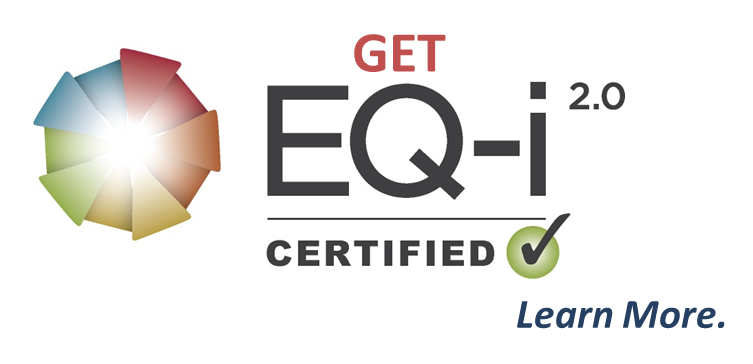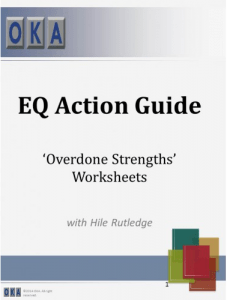Part 2: Addressing Overdone Behavior
The conclusion of “Whoa, Buddy Part 1” was that too much of any EQ behavior is as much a liability as its deficit. But surprisingly, the fix for too much of something is not to do less of it.
It is very difficult—and I would actually argue that it is impossible—to actively do less of something. For instance, if I overdo Self-Regard and show up looking and sounding arrogant and narcissistic, the remedy is not for me to think less of myself, but rather for me to engage more those behaviors that would naturally take the edge off of my self-absorption. I could pay more attention to you and your feelings, for instance. But this action would be my engaging more Empathy and/or more Interpersonal Relationships, not less Self-Regard. In fact, if I am actively working my Emotional Intelligence, I am always wanting to do more of something. I either need more of a particular element because I simply lack it, or I need it to counter an excess in another, complimentary area.
The EQ-i model of Emotional Intelligence is loaded with behavioral tensions and balancing behaviors, and understanding how to use any given element to balance the excesses of another is one of the skill sets of someone with well-developed EQ. Below are a few case studies—the same ones detailed in “Whoa, Buddy Part 1”—detailing the action steps that could be taken to balance a particular overdone EQ element.
Travis: Overdone Self-Actualization
 Travis’ unrelenting drive toward achievement and continuous improvement comes from a powerful commitment to self-improvement, but while at heart a good thing, his striving is actually alienating his boss and colleagues, who see his drive and ambition as off-putting, overdone and exhausting.
Travis’ unrelenting drive toward achievement and continuous improvement comes from a powerful commitment to self-improvement, but while at heart a good thing, his striving is actually alienating his boss and colleagues, who see his drive and ambition as off-putting, overdone and exhausting.
Travis does NOT need to care less about his work or growth; rather, he needs to stand up those EQ elements that naturally balance his drive and excessive Self-Actualization. The EQ elements that balance Self-Actualization are:
- Interpersonal Relationships
- Empathy
- Flexibility
- Reality Testing
Some Suggested EQ Actions
The following are three actions/exercises Travis could consider, each designed to activate some combination of the above elements with the intended outcome of balancing his excessive Self-Actualization.
- Travis could stop in and talk to people—investing time and exhibiting concern in them, their interests and their lives. He could ask them about themselves and actively listen to their responses. Remembering details from these exchanges (even if he has to write them down) to follow up on later is a great way for him to exhibit concern and to build a meaningful connection. In these conversations, Travis should not push the people with whom he’s talking to achieve anything or to do better—he should just listen to them and acknowledge what is important or interesting to them (This is using Interpersonal Relationships to balance Self-Actualization).
- Travis could inspect the level of performance or achievement that is expected of him by his role, job description, leader or teammates, and acknowledge the gap that separates these expectations from those set by himself. Travis should consider that his added level of striving and toil may have more personal and interpersonal costs than the added achievement yields benefits (This cost-benefit analysis uses Reality Testing to balance Self-Actualization).
- Travis could select a set goal or standard of excellence, and consider at least two other (more relaxed) outcomes that he could work toward and be satisfied with. If this kind of brainstorming is difficult for him to do on his own, he could conduct a brainstorming session with a colleague or work group to generate at least two other options—the goal is to reasonably slow down the treadmill, not lower the bar or settle for mediocrity (This is using Flexibility to balance Self-Actualization).
Stephen: Overdone Impulse Control
 Stephen’s thoughtful, cautious introversion is being experienced by his colleagues and direct reports as a lack of clarity and direction. They need his voice and input, and he too often holds them back.
Stephen’s thoughtful, cautious introversion is being experienced by his colleagues and direct reports as a lack of clarity and direction. They need his voice and input, and he too often holds them back.
Stephen’s over-engagement with Impulse Control would best be remedied by more actively engaging those EQ elements that balance his drive toward quiet, reflection and non-expression. The EQ elements that balance Impulse Control are:
- Self-Actualization
- Assertiveness
- Emotional Expression
- Problem Solving
Some Suggested EQ Actions
The following are three suggested actions/exercises from which Stephen could choose–each designed to activate some combination of the above elements with the intended outcome of balancing excessive Impulse Control.
- Stephen could find a trusted friend or family member and share his feelings about a given issue with him/her—then branch out and do this with one other person, taking the skills he had exercised within a trusted relationship and applying them to someone else, with whom he could then start to build a more trusting relationship (This is using Emotional Expression to balance Impulse Control).
- Stephen could verbalize his feelings in conversation—
- “I’m excited about this project.”
- “I’m afraid this course of action is not going to work.”
- “I enjoy working with you.”
- “I’m irritated that I have to do this.”
These statements will not have been asked for, but they are true, and making these statements will actively counter Stephen’s tendency toward non-disclosure (This is using Emotional Expression to balance Impulse Control).
- Stephen could task himself to express a position or idea in the next conversation or meeting he is in—regardless of whether he is asked, whether the idea has already been expressed by someone else or whether the idea is likely to be harmoniously received (This is using Assertiveness to balance Impulse Control).
An OKA Approach:
In an effort to cast a clear light on the effort of balancing over-done behaviors, OKA has authored an EQ Action Guide–-a series of 15 Overdone EQ Reports. Each report details what the element looks and sounds like when overdone and how it manifests in relationships, teams and organizations. Most helpfully, it then details a number of suggested actions designed to balance the overdone EQ element.Consider adding these reports (15 2-page downloadable PDFs) to your EQ toolkit. Click the image below to see or purchase OKA’s EQ Action Guide.
Other OKA EQ Resources
OKA can help by:
- Providing advanced skills for those already EQ-i Certified in our Advanced EQ Workshops
- Certifying your team to use the EQ-i 2.0. EQ-i 2.0 / EQ360 certificaton
- Delivering Emotional Intelligence development workshops for your team or organization
- Providing individual Emotional Intelligence coaching and 360 Assessments
- Providing support materials like our leading Emotional Intelligence EQ Workbook
If you would you like to learn more about any of these resources, we would be excited to hear from you. Contact Harris Fanaroff at hfanaroff@oka-online.com.



Leave a Comment